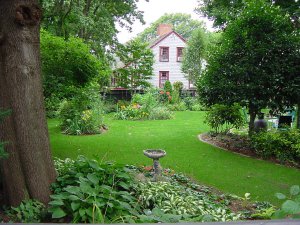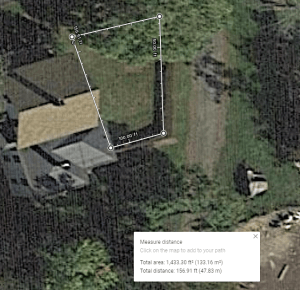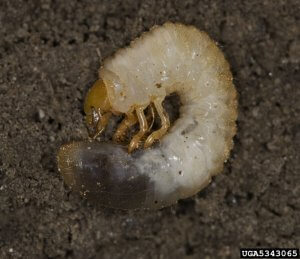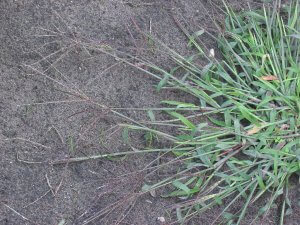Misconceptions About Well Manicured Lawns
Well Manicured lawns are often vilified by the foraging community. Homeowners are often accused of pointlessly using harmful chemicals that are bad for humans and our local ecosystems. Although this is often the case, it does not have to be. It is important to be aware of potential pesticide use when foraging, but it is also possible to have a well maintained forageable lawn that is green and healthy. Many lawn weeds are some of the best wild edibles around. Well manicured lawns have many benefits as well. Some of the benefits of a well managed lawn is for safety of use, ease of maintenance, aesthetic purposes, and sight line purposes including traffic safety. When the right techniques are used you can have a nice lawn and eat it too.
Green lawns are Healthy Lawns
 It’s important to remember that dense green lawns are healthy lawns. Many conventional techniques used today focus on eliminating pests and not on improving lawn health and resilience. When a lawn is healthy it is harder for pests to take over. This type of maintenance strategy requires a change in perspective for those who have traditionally been using maintenance methods focused on pest elimination. For example most weeds do not need to be eliminated or controlled in any significant manner to maintain a healthy turf, with a few exceptions. For those of you who are picky about weed control there are options available but more importantly I would urge you to reconsider your desire to focus on killing lawn weeds. On the contrary a diversity of lawn weeds is often a direct benefit to the local eco-system and even lawn health such as is the case with clover. There are a few pests that do sometimes need targeted control, those will be mentioned later in this article.
It’s important to remember that dense green lawns are healthy lawns. Many conventional techniques used today focus on eliminating pests and not on improving lawn health and resilience. When a lawn is healthy it is harder for pests to take over. This type of maintenance strategy requires a change in perspective for those who have traditionally been using maintenance methods focused on pest elimination. For example most weeds do not need to be eliminated or controlled in any significant manner to maintain a healthy turf, with a few exceptions. For those of you who are picky about weed control there are options available but more importantly I would urge you to reconsider your desire to focus on killing lawn weeds. On the contrary a diversity of lawn weeds is often a direct benefit to the local eco-system and even lawn health such as is the case with clover. There are a few pests that do sometimes need targeted control, those will be mentioned later in this article.
Six-Step Secret to a Healthy Lawn With no Harmful Chemicals
1. Know Your Square Footage
 To correctly maintain any lawn area it is imperative that you know the approximate area in square feet that you’re maintaining. You can always go out and measure it by hand but the easiest and most accurate method I know of is to use google map’s measure distance tool(which also measures area). Follow these step by step instructions to measure an area using google maps.
To correctly maintain any lawn area it is imperative that you know the approximate area in square feet that you’re maintaining. You can always go out and measure it by hand but the easiest and most accurate method I know of is to use google map’s measure distance tool(which also measures area). Follow these step by step instructions to measure an area using google maps.
- Go to https://www.google.com/maps in any internet browser.
- Click on the bottom left satellite image to switch to satellite mode.
- Search for your location in the search bar then zoom in on the area to be measured.
- Click on the menu button at the top left next to the search bar( it looks like 3 horizontal lines) then click on “3D on” to shut off 3D mode.
- Right click on the screen and click on “measure distance”.
- Follow the instructions at the bottom of the screen to draw a polygon around the area.
- For your last point in the polygon click on your first point which will close the polygon, the line distance and area square footage will display on the screen.
2. Get a Soil Analysis
This is by far the most under-utilized tool to improving lawn health. This should be done every 2-3 years to maintain a healthy lawn. You can often get a soil analysis for free from a local state agricultural center or agricultural college. The most important Item to look at on the report is the soil PH. The second most important items to look at are the primary nutrients (Nitrogen, Phosphorus, Potassium) and the secondary nutrients( Calcium, Sulfur and Magnesium). All the secondary nutrients are not always included in the report but the important ones for your area should be. The report might also include a long list of micronutrients this is not typical on free soil analysis reports, these are the last items to consider. Many soils already contain enough micro nutrients to support a healthy lawn. If you have corrected the soil PH as well as primary and secondary nutrients then you might consider attempting to correct the micronutrient levels but it’s usually not necessary.
3. Correct the Soil PH
Knowing your soil PH is the most important step to improving any lawn. To check your soil PH regularly homeowners should get a soil PH meter. The optimal PH for cool season grasses is 6.5. The simple rule is if your soil is too acidic(low PH) add limestone, if its too alkaline(High PH) add sulfur. I recommend granular products and not powdered products. your soil report will tell you how much to add. Soil PH takes a long time to change, you may not see results for 6 months, and you will likely continue to see results for over a year after an application to change soil PH. In temperate climates it is a good idea to add lime or sulfur in late fall and let it work its way into the soil with the intention of seeing some lawn improvements in the spring. Follow all directions from the soil report and from the product packaging. Do not apply more then the recommended amount in one application and always wait the recommended amount of time before the next application. For example, granular dolomitic limestone should not be applied at more than 50 lbs per 1000 sq.ft. every 4-6 months.
4. Maintain Nutrient Levels
Nutrient levels should be treated differently then lime. Nutrients enter the soil quickly and are available to the plant quickly. Certain nutrients also leave the soil quickly. As a general rule of thumb most nutrients other than nitrogen can usually stay in the soil for 6 months to a year and a half depending on conditions. Nitrogen is the exception and it is one of the most important nutrients for lawn growth. Nitrogen is added quickly to the soil in fertilizer and it can leave the soil quickly as well. The primary purpose for a multi-application annual lawn fertilization program is simply to keep nitrogen levels steady throughout the year. There are natural processes that cycle the nitrogen from the air to the soil and back again, but if your local soil conditions don’t promote high nitrogen levels then it will be important to fertilize at least 2 times a year. Slow release nitrogen is commonly found in synthetic and all natural lawn fertilizers to help steadily release nitrogen over time. Other nutrients should be applied based on soil analysis results and recommendations.
5. Effective Cultural Practices
Cultural practices typically refer to anything that you do to your lawn that does not include pesticide and fertilizer applications. This section will cover best mowing practices, best watering practices, aeration/dethatching and overseeding.
Best Mowing Practices
Generally mowing should be done weekly during the growing seasons at around 3.5″ and clippings should NEVER be bagged. This height is higher then most people are comfortable with. It is important to leave the grass blades long when dealing with any lawn stresses such as insects, crabgrass pressure or drought stress. In the spring you can cut it shorter(2.5″-3″) unless you’re dealing with crabgrass pressure because you want to shade out newly developing crabgrass. In the summer you can cut it longer ( up to 4″) if your dealing with any type of stress. In the fall you can and should cut it shorter(2″-2.5″) so that going into winter and next year’s potentially wet spring you don’t develop snow mold or other cold weather fungal problems. When the lawn is actively growing it should be mowed at least weekly. If it seems to be getting out of control don’t reduce the height just mow it twice a week for a few weeks during its most active growth period. Generally you should never remove clipping. They do not contribute to thatch build up, they actually help reduce it as well as helping the lawn in other ways. If you’re on an annual fertilization program and have very few issues with your lawn and the clippings really bother you then you can go ahead and remove the clippings but otherwise they offer many benefits to the lawn. Use a powerful enough lawn mower that will not get clogged often. Also make sure blades stay sharp and continue to cut the blades of grass and not shred them.
Best Watering Practices
Generally watering deeply and infrequently is best. For example watering for a half hour 2 days a week is better then 15 minutes 4 days a week. A rough guideline for watering frequency is 2-3 days a week for a half hour early in the morning. This should be adjusted based on results and weather patterns. The best time to water is early morning. If you water in the evening, especially on hot days you could promote lawn fungus. If you don’t have an irrigation system you can buy a timer, hose and sprinklers and set up a very inexpensive irrigation system that should need very little management after the initial set up. All this being said healthy cool season lawn grasses that are not watered will usually go dormant in the summer and recover very quickly in the early fall, therefore irrigation is typically not required. Although they look similar there is a huge difference between a lawn dying from lawn fungus in the summer and a lawn going dormant in the summer. A dormant lawn will often keep the rigidity of the blades. they will look sort of like straw or hay. A lawn dying of disease will have patches that eventually “melt out” which means they fall down into a mat and start to decay.
Aeration/Dethatching
Aeration is the act of puncturing holes in the soil and thatch. Dethatching is scraping the surface to remove a dense thatch layer. Thatch is built up organic matter such as dead stems and roots at the soil level that is not decaying as it should be. A layer of thatch less than a half inch is not a problem and will often add benefits to the lawn. If your thatch layer is far from half an inch then you may be promoting drought conditions, fungus, or harmful insect habitat. Leaving lawn clippings in the lawn will not add to your thatch layer and may actually promote fungus and bacteria that break down thatch. If your soil PH and nutrients are correct then your thatch layer should not get too dense. If you have confirmed that you do have a dense thatch layer you can dethatch or aerate once a year while your waiting for your PH to improve. Dethatching can be done by hand with a metal tine rake or dethatching rake. You can also do it mechanically with a dethatching machine. My recommendation is typically to not dethatch at all but aerate instead. Dethatching is very time consuming and doesn’t have the benefits that aeration Does. Core aeration is a type of aeration that pulls small cores of soil out of the ground and places them back on the surface. The divets that are made in the lawn offer a place for oxygen, nutrients and water to remain while working their way into the soil. The cores can be left on the surface to break down. The only way to aerate effectively is with an aeration machine. You can rent an aeration machine from a local hardware rental center. Aeration and dethatching machines can be strenuous and potentially dangerous to operate. This is one step that I would recommend hiring a professional. You can usually get the area core-aerated for $10-$50 per 1000 square feet. The price per 1000 sq. ft. will usually decrease as the total area to be done increases.
Overseeding
Proper overseeding is an important practice to understand and be able to utilize when it’s beneficial. The most important thing to realize regarding seeding is that soil that can not support grass will not support grass. This sounds obvious right? Many people see bare spots in the lawn and decide it needs seed. They make no consideration of why the spot is bare in the first place. It is true that young seedlings seem to do great even in poor environments. Don’t be fooled, this will not last long. First figure out why an area is not growing grass. It is either soil conditions( ph, nutrients, shade, drought….), crabgrass or insects(often white grubs). Once you have figured out why the area hasn’t grown grass you can correct the problem and apply more seed. Seed should only be applied in early spring or early fall. It should be watered twice a day for about 15-20 minutes each(once early morning and once in the early afternoon). New seed should be fertilized with starter fertilizer at the label rate. The seed variety that you choose is important and should match the soil conditions. Seed mixes are usually better then choosing one specific seed. A seed mix will include a diverse collection of seeds that all visually compliment each other. The variety that does the best in any specific microclimate of your yard will thrive in that area. Choose a seed mix for residential lawns specifically. Don’t choose a “sports mix” or “grass that grows anywhere” or anything like that. The best option is a “sun and shade mix” or “shade mix” for lawns in your area. To apply seed correctly first the soil should be agitated. This can be done by hand with a rake or mechanically with a power rake, dethatcher or aerator. The next step is to apply the seed at the label rate on the bag. The next step is to fertilizer with starter fertilizer. The final step is to cover with chopped straw or hay mulch at about 1/4″ depth. As mentioned before I recommend purchasing sprinklers and hose timers if you don’t have irrigation and setting them for 15 minutes twice a day for about 6 weeks. Continue with a watering program that fits your climate after that.
6. Major Pest Control
There are a few major insect pests that can cause damage even to healthy lawns, The most common is white grubs. These are larvae of a number of beetle species. The eggs are layed in summer and they do most of their damage in early fall. You can inspect for white grubs in September by simply scooping up a shovel-full of soil at a time and digging through the loose soil for white grubs. Other notable pests are bluegrass billbugs, sod webworms and chinchbugs. There is also one major weed that can out compete grass, this is crabgrass. It is a summer annual, It germinates in late spring. It grows best in hot conditions when cool season lawn grass is struggling, then it sets overwintering seed in the fall and it dies. These pests will sometimes work in conjunction with each other, grubs kill the lawn then crabgrass moves in to keep it down.
 Controlling lawn insects organically without chemicals
Controlling lawn insects organically without chemicals
- The first defense against lawn insects is simply a thriving lawn that can quickly recover after the insect damage has been done. This is achieved by correcting soil ph, nutrients and using the best cultural practices for your lawn.
- The second defense is a biological control method. Nematodes work relatively well for white grub control. The trick to making this method effective is that the application must be done with the right species of nematode, at the right time of year, at the right time of day(late afternoon), with the right amount of water and the right air temperatures.
 Controlling crab grass organically without chemicals
Controlling crab grass organically without chemicals
- This pest is difficult to control initally but relatively easy to maintain control once you have it. Your best chance to start controlling crabgrass is to fix the soil PH. When controlling crab grass you have to be careful when doing nitrogen fertilization applications. Do them only in cool weather such as early spring and late fall when crab grass is not functioning efficiently. During the spring and summer cut the lawn as high as 4″ weekly(don’t skip any weeks) if you can. This will shade out crabgrass and improve lawn resilience during the hot dry parts of the summer
- Another tool at your exposure is organic herbicides such as agricultural vinegar or citrus oil. This is not a selective herbicide so it will kill anything that you spray it on. Use this product to kill individual large plants or large patches of crabgrass in late summer, then install desirable grass seed and fertilizer.
Weed Control Options
As was mentioned earlier in this article weed control is generally not necessary to have a healthy green lawn. Many great wild edibles reside in the lawn such as wild garlic, wild violets, bittercress, purslane, chicory, wood sorrel, yard plantain, sheep sorrel and others.
For specific weeds that might be spreading more than desired, organic weed control options are available. The most effective organic weed control options are non-selective products such as concentrated vinegar and concentrated citrus oil. Non-selective products will kill both desirable lawn species as well as weeds, therefore targeted treatment is required. Concentrated vinegar and concentrated citrus oil both work by damaging the protective waxy layer on plant foliage which causes foliage to lose moisture and die. These products must be applied properly and during hot dry weather. Since these products damage foliage specifically they must be sprayed directly on the foliage. Make the applications in late morning or early afternoon which will cause the plant to lose moisture rapidly during the hottest part of the day.
Synthetic Lawn Pest Control Options
I personally believe that limited use of synthetic pest control products can be useful especially for the initial establishment of a healthy lawn. Crab grass, grubs and other lawn insects respond quickly and thoroughly to conventional synthetic products. Once large pest populations are reduced and lawn health is improving, synthetic products use can be permanently suspended and organic products can be used to control the now smaller pest populations.
Changing Expectations – Creating Healthy Lawn Ecosystems
Harsh chemicals that are used to treat for lawn insects and weeds can make their way into all organisms in a lawn eco system. This could destroy the diversity of the lawn ecosystem as well as getting into any forageable lawn weeds. The largest popularly held misconception about lawns is that a healthy lawn is a weedless lawn. The second largest popularly held misconception is that a green healthy lawn can’t be had without harmful chemicals. I urge my readers to prove both of these misconceptions wrong by having a healthy green lawn full of diverse lifeforms including a variety of grasses, leafy plants, insects and other small animals. If you have always wanted a healthy green lawn but are conscientiously opposed to using harmful chemicals now you know how to do both.
Do you have more questions or want more information? Please post comments below.
Many of our readers find that subscribing to Eat The Planet is the best way to make sure they don't miss any of our valuable information about wild edibles.
See our privacy policy for more information about ads on this site







One Response
Thanks so much! 🙂